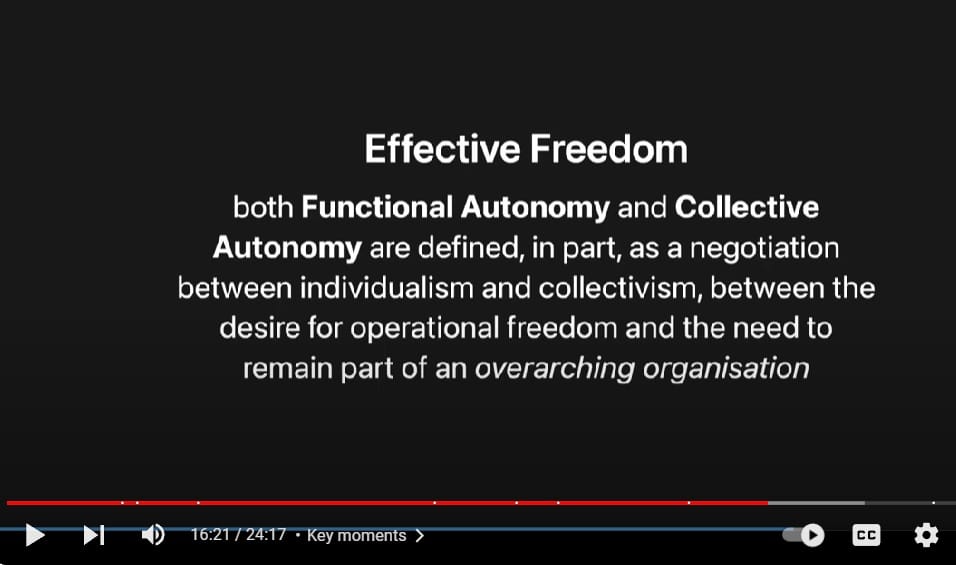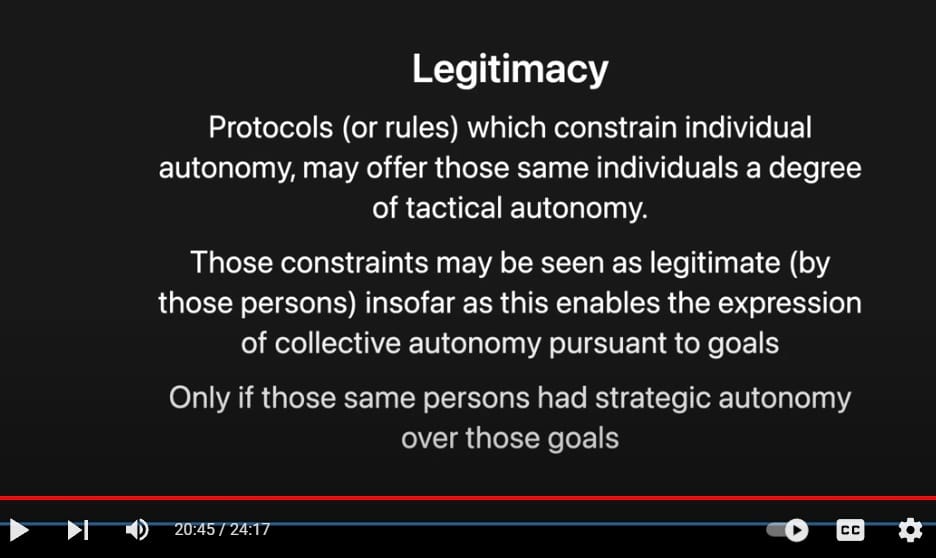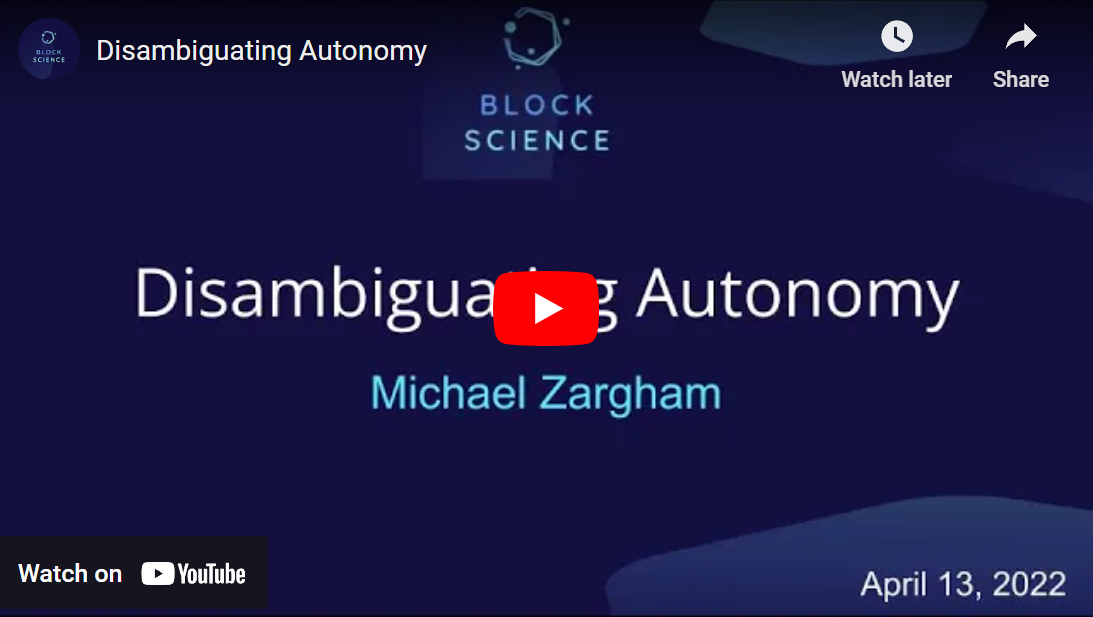Disambiguating Autonomy Video
In this video, BlockScience Founder and Chief Engineer Dr. Michael Zargham breaks down the concepts of political and functional autonomy to illustrate four sub-types of autonomy - individual, collective, tactical, and strategic - outlining a common language for designing and validating healthy cybernetic organizations.
This talk has informed a comprehensive article on Disambiguating Autonomy: Ceding Control in favor of Coordination expanding the distinctions discussed in this video, and examining the tensions and trade-offs of the four types of autonomy within the context of emergent, self-organizing systems. In this post, we provide a chronological overview of the topics discussed by Dr. Zargham in the April 2022 video: 'Disambiguating Autonomy'.
Video Topics
[00:00:00] “Anarchist Cybernetics: Control and Communication in Radical Politics” by Thomas Swan, Chapter 5: Control Part 2
Dr. Zargham introduces the key reference for the discussion of autonomy, emphasizing relevance and importance in various contexts. The discussion explores the different dimensions and applications of autonomy based on political and functional notions.
[00:00:30] Types of Autonomy
The broad notion of autonomy is categorized into two different categories and four sub-types, each type has distinct characteristics and implications, which will be discussed in detail.
[00:02:45] Functional Autonomy

The degree of flexibility an individual or group within an organization has to respond to complexity as they see fit
Functional autonomy is defined as the ability of a system or individual to operate independently and perform tasks without external control. An example of an autonomous car with tactical functional autonomy that can act and respond to its environment according to its goals and constraints is seen as analogous to software systems.
[00:01:05] Political Autonomy
Political autonomy refers to the self-governance of individuals and groups. The discussion focuses on the balance between individual and collective autonomy, and the necessary tradeoffs that enable group decision-making.
[00:02:30] Collective Autonomy

collective autonomy is the collectively determined capacity and scope an individual or group has to decide and act within the constraints set by collective organization
In a sense, collective autonomy is what we can do together and describes the capacity of a group to make decisions and act within a set framework. The importance of collaboration and shared goals in achieving collective autonomy is emphasized.
[00:02:50] Types of Functional Autonomy
Using the example of a coastguard, Zargham offers a real-life example of how to differentiate between the two subtypes of functional autonomy—tactical and strategic autonomy.
[00:05:00] Interplay Between Functional and Political Autonomy
"...Tactical functional autonomy makes political decentralization possible..."
The interaction between functional and political autonomy is explored, with examples of how functional and political autonomy manifest, the challenges they present, and the argument for subsidiarity.
[00:09:15] Intuition Check: Strategic vs Tactical Autonomy
Would you get in an autonomous car if you did not get to decide where it was taking you?
[00:11:00] Constraints on Autonomy

A discussion of the following constraints on autonomy
1. autonomous parts must operate in coordination with other autonomous parts.
2. autonomous parts must operate within the intentions of the whole organization.
3. autonomous parts must face the possibility of being excluded from the organization
[00:014:30] Consensus Decision Making
From a technical perspective consensus protocols provide a means through which software agents in a peer-to-peer network agree on the state of the world, through collective and tactical autonomy. From a social perspective, the creation of shared rules that everyone can support is achieved through collective and strategic autonomy.
[00:16:20] Effective Freedom

Both functional autonomy and collective autonomy are defined in part as a negotiation between individualism and collectivism, between the desire for operational freedom and the need to remain a part of an overarching organization.
Effective freedom is the individual choice to participate in the whole and to be constrained by the rules of the whole, with the understanding that individuals (and groups) can expect to be excluded from the network if their choices contradict the collective rules.
Protocols such as those used in peer to peer networks are clearly stated rules such that failure to adhere is tantamount to (self) exclusion
[00:18:40] Legitimate Constraints on Autonomy
On legitimacy, it is noted that people must endorse the regulatory model at the heart of the viable system in which they participate. This is seen as strategic autonomy as there is some necessary decision about the regulatory model that describes or defines the system, which people have to endorse to choose to become a part of the organization.

Protocols (or rules) which constrain individual autonomy, may offer these same individuals a degree of tactical autonomy. Those constraints may be seen as legitimate (by those persons) insofar as this enables the expression of collective autonomy pursuant to goals. Only if those same persons had strategic autonomy over those goals
[00:21:50] Mechanisms for Enforcing Rule Sets
Zargham notes that systems that have their rules baked into them - in a physics-like way - behave differently than systems that work through enforcement by coercion.
One way of enforcing rules is with power, another way is the way that physics works,which is that some rules, simply are the way things work and no amount of trying would violate them, conservation of energy, for example. Much of the programmatic mechanism design that we do involves systems that simply work the way they work and you would exclude yourself rather than break the system.
Most of the cybernetics literature is applied social science of control theory and dynamical systems and a useful way to reason about engineering mechanisms or engineering institutions through the construction of rules.
About BlockScience
BlockScience® is a complex systems engineering, R&D, and analytics firm, integrating ethnography, applied mathematics, and computational science. We analyze and design safe and resilient socio-technical systems, and with deep expertise in market design, distributed systems, and AI, we provide systems engineering services to a wide range of for-profit, non-profit, academic, and government clients.


